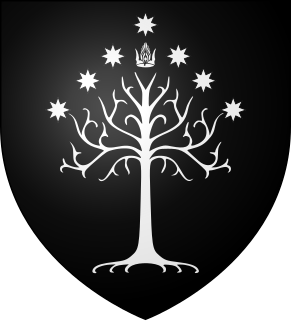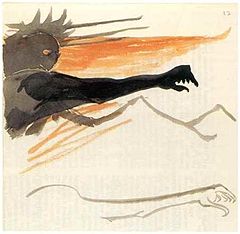The Reunited Kingdom of Arnor and Gondor is a fictional realm from J. R. R. Tolkien's Middle-earth.

Arnor is a fictional kingdom in J. R. R. Tolkien's writings. Arnor, or the North-kingdom, was a realm of the Dúnedain in the region of Eriador in Middle Earth. Arnor was founded near the end of the Second Age (S.A. 3320) by Elendil, whose sons Isildur and Anárion founded Gondor at the same time. The history of the two kingdoms is intertwined; both kingdoms are known as the Realms of the Dúnedain in Exile.

Gondor is a fictional kingdom in J. R. R. Tolkien's writings, described as the greatest realm of Men in the west of Middle-earth by the end of the Third Age. The third volume of The Lord of the Rings, The Return of the King, is largely concerned with the events in Gondor during the War of the Ring and with the restoration of the realm afterward. The history of the kingdom is outlined in the appendices of the book.

John Ronald Reuel Tolkien was an English writer, poet, philologist, and academic, who is best known as the author of the classic high fantasy works The Hobbit, The Lord of the Rings, and The Silmarillion.
Contents
When Aragorn became King of Gondor at the end of the War of the Ring, he was also the descendant of the Kings of Arnor, and by right he was crowned High King of both Arnor and Gondor and Reunited the Two Kingdoms, which had politically split long ago. Using the resources of the victorious Gondor, Aragorn, taking the royal name King Elessar, rebuilt Arnor in the North.
Aragorn II, son of Arathorn is a fictional character from J. R. R. Tolkien's legendarium. He is one of the main protagonists of The Lord of the Rings. Aragorn was a Ranger of the North, first introduced with the name Strider at Bree, as the Hobbits continued to call him throughout The Lord of the Rings. He was eventually revealed to be the heir of Isildur and rightful claimant to the thrones of Arnor and Gondor. He was also a confidant of Gandalf and an integral part of the quest to destroy the One Ring and defeat the Dark Lord Sauron.
In the fictional high fantasy-world of J. R. R. Tolkien, the War of the Ring was fought between Sauron and the free peoples of Middle-earth for control of the One Ring and dominion over the continent. The War of the Ring took place at the end of the Third Age. Together with the Quest of Mount Doom, it is one of the overarching events of The Lord of the Rings. Gandalf and Elessar Telcontar led the free peoples of Middle-earth to victory over the Dark Lord.
In J.R.R. Tolkien's Middle-earth, the High Kings of Arnor and Gondor were the Kings of all Dúnedain in Middle-earth after the Downfall of Númenor. Elendil was the leader of the Elendili who survived the Downfall. He claimed the title of High King.
With the defeat of Sauron and Mordor, the Reunited Kingdom of Aragorn was without question the dominant power of Northwest Middle-earth during his long reign.

Sauron is the title character and main antagonist of J. R. R. Tolkien's The Lord of the Rings.

In J. R. R. Tolkien's fictional world of Middle-earth, Mordor is the realm and base of the arch-villain Sauron. It was located in the southeast of northwestern Middle-earth, east of the great river Anduin. Mount Doom, a volcano in Mordor, was the goal of the Fellowship of the Ring in the quest to destroy the One Ring.
During Aragorn's reign, the Reunited Kingdom expanded to retake all territories that had originally belonged to both Arnor and Gondor at their greatest extents, excluding only Rohan (the grant of which he renewed), and the Shire, the Druadan Forest, and Fangorn Forest (which became protectorates).

Rohan is a kingdom in J. R. R. Tolkien's fantasy setting of Middle-earth. It is mainly a grassland, and lies north-west of its ally Gondor, and further north-west of Mordor, the realm of Sauron, their enemy. It is inhabited by the Rohirrim, a people of herdsmen and farmers who are well known for their horses and cavalry. The realm is of significant importance in the author's book, The Lord of the Rings. Much of the background of Rohan is grounded in Anglo-Saxon tradition.
The Shire is a region of J. R. R. Tolkien's fictional Middle-earth, described in The Lord of the Rings and other works. The Shire refers to an inland area settled exclusively by Hobbits and largely removed from the goings-on in the rest of Middle-earth. It is located in the northwest of the continent, in the large region of Eriador and the Kingdom of Arnor. In the languages invented by Tolkien, its name in Westron was Sûza "Shire" or Sûzat "The Shire", while its name in Sindarin was i Drann.
Additionally, during the 1st century of the Fourth Age Aragorn led the armies of the Reunited Kingdom in many successful military campaigns that retook the province of South Gondor (Harondor), re-established dominance over Rhovanion (Wilderland) eastwards to the Sea of Rhûn [ citation needed ], and conquered the Corsairs of Umbar, who had attacked Gondor during the War of the Ring. Umbar had originally been a Númenórean port and an important city of Gondor in ancient times before ultimately being conquered by the followers of Castamir following the Kin-strife, who distanced Umbar from Gondor and befriended Harad. Elessar finally reconquered the city, and the Reunited Kingdom stretched South along the coast from the Mouths of the Anduin River to the Haven of Umbar. Much of Harad was defeated and became tributary states.[ citation needed ] Aragorn was also held to be the protector of Dale (which included Esgaroth), and the Dwarf realm of Erebor,[ citation needed ] although these allies maintained their own rule and kings. Aragorn is assumed to have rebuilt the old northern capital of Annúminas. [1]
The Fourth Age is one of the divisions of history in J. R. R. Tolkien's fictional world of Middle-earth. Because most of his fiction deals with earlier ages, there is relatively little material on the ages that followed the Third Age.
In the fiction of J. R. R. Tolkien, Rhovanion or Wilderland was a large inland region of north-east Middle-earth. It is the scene of action for much of The Hobbit and some episodes of The Lord of the Rings.
The only threats or rivals to the Reunited Kingdom into the Fourth Age would have been the Haradrim, who had not been subjugated, and the Easterlings.
